Pharmacokinetics Important Notes
- Pharmacokinetics
- It is the study of drug absorption, distribution, biotransformation, and excretion
- Bioavailability
- It is the amount or percentage of drug that is absorbed from a given dosage form and reaches the systemic circulation following nonvascular administration
- Biotransformation
- It is the alteration of a drug within living organisms
- After absorption drug circulates in the blood either in free form or bound to plasma proteins
- The protein-bound drug is inactive and acts as a temporary store
- The liver is the most active site for metabolizing the drugs
- The enzymes that bring about biotransformation are microsomal enzymes
- Routes of excretion of the drug
- Lungs – alcohol, paraldehyde
- Skin – arsenic, heavy metals
- Bile – erythromycin, tetracycline, glycosides
- Milk – erythromycin, tetracycline, penicillin
- Saliva – metronidazole, heavy metals
- Tears – rifampicin, minocycline
- First order kinetics
- Elimination of a drug occurs exponentially
- A constant fraction of the drug disappears in each equal interval of time at the rate proportional to its plasma concentration
- It occurs in lower dosage levels
- Zero-order kinetics
- When the dose exceeds a certain critical level, eliminating mechanism gets saturated
- A fixed quantity of drug is eliminated per unit of time
- Methods of prolonging drug action
- Retarding absorption
- Inhibiting drug metabolism in the liver
- Slowing renal excretion of the drug
- Increased protein binding of the drug in plasma
- Drugs are transported across the membrane by
- Passive diffusion and filtration
- Specialized transport
- Drug dosage
- Clarke’s rule
-
- Young’s rule
Pharmacokinetics Long Essays
Question 1. Describe the various methods to prolong the duration of action of the drug.
Answer:
The duration of action of drugs can be prolonged by in-interfering with the pharmacokinetic processes.
- It has the following advantages:
- Reduces frequency of drug administration.
- Improves patient compliance.
- Avoids large fluctuations in plasma concentration.
- Maintains drug effect overnight.
Prolong The Duration Of Action Of The Drug Methods:
1. By prolonging the absorption:
- The oral route prolongs absorption by 4-6 hours.
- Used sustained-release preparation, coating with resin, plastic, etc. Temporarily disperse the release of the active ingredient in the GIT.
- Used the semipermeable membrane to control the release of the drug.
- Example: Iron, dyphylline.
- Parenteral route – prolongs absorption up to days to several months.
- Reducing solubility – Example: procaine + penicillin.
- Use of oily solution depot progression.
- Altering particle size – Insulin zinc suspension.
- Pellet implantation – DOCA.
- Statistic capsules – testosterone.
- Inclusion of vasoconstrictor with the drug adrenaline with local anesthetics.
- Combining with protein – protamine + zinc + in-caution.
- Chemical alteration through esterification.
- Transdermal drug deliver:
- Use of transdermal patch.
Read And Learn More: Pharmacology Question and Answers
2. By increasing plasma protein binding:
- Drugs that are highly bound to plasma protein are pre- pared & are released slowly in the free active form.
- Example: sulphonamides.
3. By Retarding the rate of Metabolism:
- By chemical alteration of drug – Example: addition of ethical group to estradiol.
- Inhibiting specific enzymes.
- Inhibition of enzyme cholinesterase by posting- mine prolongs the action of acetylcholine.
- Inhibition of enzyme peptidase in the renal tubules by cilastatin – prolongs the action of imipenem.
4. By Retarding Renal Excretion:
- Use of competitive substances, which competes for the same transport system.
- Example: Probenecid pro- longs the action of penicillin and ampicillin.
Question 2. Explain the means of biotransformation of drugs in the body with examples.
Answer:
Biotransformation:
- Biotransformation is the process of chemical alteration of the drug in the body.
- It converts the drugs into more polar, water-soluble compounds so that they are easily excreted through the kidneys.
Site of Biotransformation:
- Liver – most important organ.
- Other includes kidney, gut, mucosa, lungs, blood & skin.
Biotransformation Consequences:
- Inactivation.
- Active metabolites & drugs are converted to inactive or less active substances.
- Example: Lidocaine, ibuprofen.
- Active metabolite from an active drug.
- Activation of the inactive drug.
- Enzymes in biotransformation:

Reactions in Biotransformation:
1. Phase 1 reactions or non-synthetic reactions.
It converts the drug to a more polar metabolite by oxidation, reduction, or hydrolysis.
- Oxidation.
- It involves the addition of oxygen or negatively charged radicals or either the removal of hydrogen or positively charged radicals.
- They are mostly carried out by a group of mono-oxygenases in the liver.
- They are the most important drug metabolizing reactions.
- Reduction.
- It involves cytochrome P-450 enzymes working in opposite directions.
- Hydrolysis.
- This cleavages of drug molecules by taking up a molecule of water.
2. Phase 2 reactions or synthetic reactions.
- In it, endogenous water-soluble substances combine with the drug or its phase 1 metabolite to form a highly polar conjugate.
- Various synthetic reactions are:
- Glucuronide conjugation.
- It is a most important synthetic reaction.
- Carried out by a group of UDP-glucuronosyl transferases.
- Acetylation.
- Compounds having amino or hydrazine residues are conjugated with the help of acetyl cohen- zyme-A.
- Methylation.
- Amines & phenols can be methylated.
- Sulfate conjugation.
- Phenolic compounds & steroids are sulfated by sulfotransferases.
- Glycine conjugation.
- Salicylates are conjugated with glycine.
- Glutathione conjugation.
- Serves to inactivate highly reactive quinine or epoxide intermediates formed during metabolism.
- Ribonucleoside.
- Required for activation of many purine & pyrimidine antimetabolites used in cancer chemotherapy.
Pharmacokinetics Short Essays
Question 1. Channels of drug excretion.
Answer:
Drug & their metabolites are excreted.
1. Urine.
- Through kidney.
- A most important channel for the majority of drugs.
- It takes place in three steps.
- Glomerular filtration.
- Ionized drugs of low molecular weight are easily filtered through the glomerular membrane.
- All nonprotein drugs are presented to the glomerulus for filtration.
- Tubular reabsorption.
- It depends upon lipid solubility & ionization of the drug at the existing urinary pH.
- Tubular secretion.
- It involves the active transfer of organic acids & bases by two separate classes of nonspecific transporters.
2. Faeces:
- Unabsorbed portions of the orally administered drugs are eliminated through the faeces.
- Most of the drug present in it is derived from bile.
- Certain drugs are excreted directly in the colon.
3. Exhales air:
- Gases & volatile liquids are eliminated by the lungs.
4. Saliva & sweat.
- Drugs like phenytoin and metronidazole are excreted through saliva.
- Drugs like iodide and rifampicin are excreted through sweat.
5. Milk.
- The excretion of drugs in the milk is of no significance to the mother, but the infant receives the drug during suckling.
Question 2. First pass metabolism/Pre-systemic metabolism.
Answer:
First-pass metabolism is the metabolism of the drug during its first passage from the site of absorption into the systemic circulation.
- Most of the orally administered drugs have to pass via the gut wall, portal vein & liver to enter the systemic circulation.
- Certain drugs during this process of passage get metabolized & are removed or inactivated before they reach systemic circulation.
- This process is known as first-pass metabolism.
- Its extent depends on the individual & the drug.
- Bioavailability is increased in patients with hepatic diseases.
Result of first-pass metabolism:
- Decreases bioavailability of the drug.
- Decreases the therapeutic effect of the drug.
Pre-systemic metabolism Consequences:
- The dose has to be increased.
- The route of administration has to be changed.
Examples: Phenobarbitone has low first-pass metabolism & lidocaine has high first-pass metabolism.
Question 3. Bioavailability mentions factors influencing it by oral route with examples.
Answer:
Bioavailability:
- Bioavailability is the fraction of a drug that reaches the systemic circulation following administration by any route.
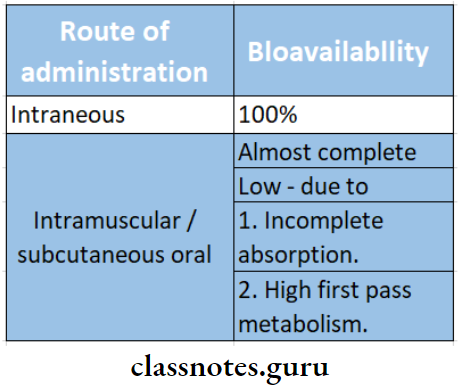
Factors influencing it:
- Disintegration & dissolution.
- Oral drugs have to be disintegrated to be absorbed & then dissolved in gastrointestinal fluids.
- Liquids → faster absorption→ good bioavailability.
- Formulation.
- Inert substances used with diluents’ slow absorption reduce bioavailability.
- Particle size.
- Small particles have easy absorption → better bioavailability.
- Lipid solubility.
- Lipid-soluble drugs- fast absorption → more bioavailability.
- pH & ionization.
- lionized drugs – poor absorption → less availability.
- Acidic drugs unionized and rapidly absorbed → good bioavailability.
- Area & vascularity of the absorbing surface.
- Larger area – more vascularity → more absorption → more bioavailability.
- Gastrointestinal motility.
- Faster gastric emptying → fast passage into the intestine → more absorption→ more bioavailability.
- Presence of food.
- Delayed gastric emptying → delay absorption.
- Metabolism.
- Degradation of drugs in GIT leads to zero bioavailability.
- Diseases.
- Liver diseases lead to increased bioavailability.
Question 5. Various methods to prolong drug action.
Answer:
1. By prolonging the absorption
- Oral route
- Prolongs absorption by 4-6 hours
- Used sustained-release preparation, coating with resin, plastic, etc
- Temporarily disperse release of the active in-gradient in the GIT
- Use of semipermeable membrane to control the release of drug
- Parenteral route
- Prolongs absorption upto days to several months
- Reducing solubility
- Use of oily solution
- Altering particle size
- Pellet implantation
- Siastic capsules
- Inclusion of vasoconstrictor with drugs like adrenaline
- Combining with protein
- Chemical alteration through esterification
- Combining with protein
- Inclusion of vasoconstrictor with drugs like adrenaline
- Siastic capsules
- Pellet implantation
- Altering particle size
- Use of oily solution
- Reducing solubility
- Prolongs absorption upto days to several months
- Transdermal route
- Use of the transdermal patch
2. By increasing plasma protein binding
- Drugs that are highly bound to plasma proteins are prepared and are released slowly in the free active form
3. By retarding the rate of metabolism
- By chemical alteration of drug
- Inhibiting specific enzyme
4. By retarding renal excretion
- Uses of competitive substances which compete for the same transport system
Pharmacokinetics Short Answers
Question 1. Pharmacokinetics.
Answer:
Pharmacokinetics is the study of the absorption, distribution, metabolism & excretion of drugs i.e., the movement of the drug into, within, and out of the body.
- Once a drug is administrated→ it is absorbed → enters blood distributed to different parts of the body → reaches the site of action metabolized and excreted out of the body.
- It depends upon.
- Route of administration.
- Dose
- Latency of onset.
- Time of peak action.
- Duration of action.
- Frequency of administration.
Question 2. Mention factors affecting bioavailability.
Answer:
- Disintegration & dissolution of the drug.
- Formulation.
- Particle size.
- pH & ionization.
- Lipid solubility.
- Gastrointestinal motility.
- Presence of food.
- Metabolism.
- Area & vascularity of absorbing surface.
- Diseases.
Question 3. Mention channels of excretion of drug with examples.
Answer:
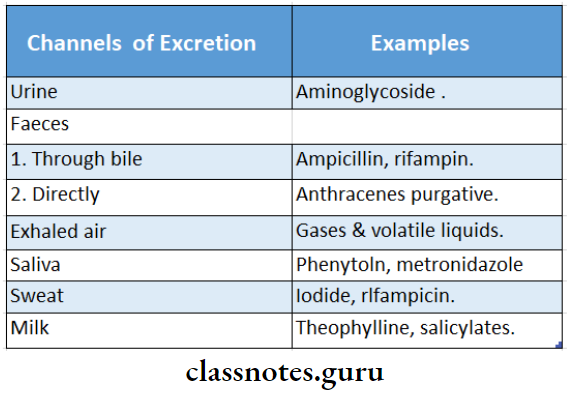
Question 4. Methods of prolonging effects of the drug with examples.
Answer:
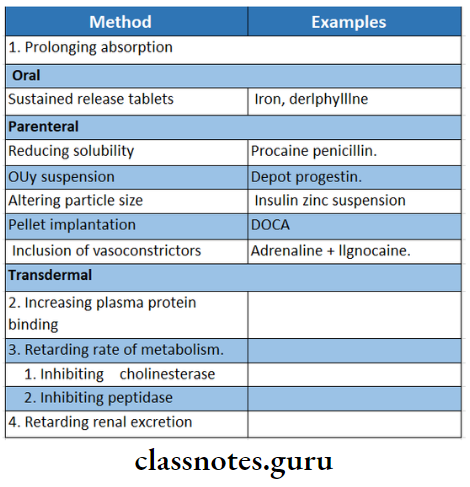
Question 5. Plasma half-life
Answer:
The plasma half-life (t1/2) of the drug is the time taken for its plasma concentration to be reduced to half its original value.
Plasma half-life Phase:
- Initial rapid phase.
- Due to distribution.
- Declined phase.
- Occurs due to elimination.
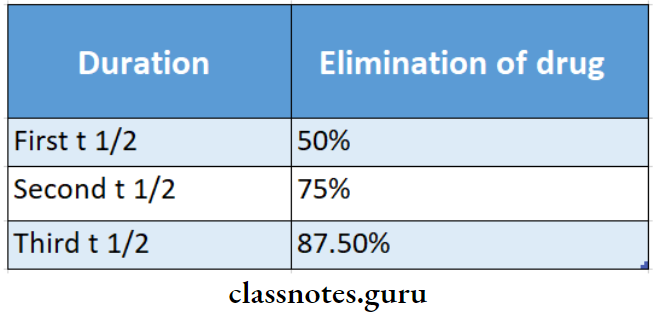
- Four to five half-lives are required for the complete elimination of the drug.
Plasma half-life Significance:
- Calculate the loading & maintenance dose of the drug.
- Indicates the duration of action of the drug.
- Guides dosing regimen.
Question 6. Drug dosage.
Answer:
A dose is the appropriate amount of a drug needed to pro- duce a certain degree of response in a patient.
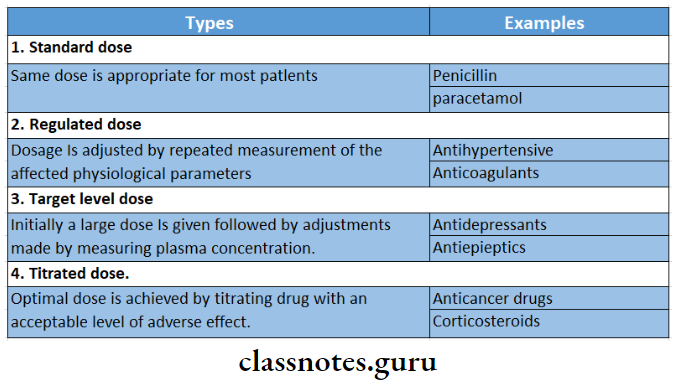
Viva Voce:
- Acidic drugs are rapidly absorbed from the stomach
- Most of the drugs are absorbed by passive diffusion
- Propranolol has extensive first-pass metabolism
- Drugs are eliminated from the body by first-order kinetics or zero-order kinetics
